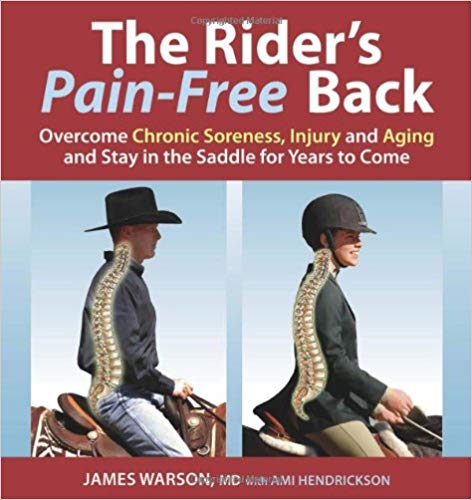By James Warson, MD with Ami Hendrickson
Horseback riders know that, sooner or later, pain will be part of the equestrian experience, whether it is the traumatic pain of a 1,000 pound animal stepping on your foot, or the chronic type resulting from overstressing a body part. The goal is to mitigate the pain and keep riding.
Back injuries and pain are a major cause of riders being forced to hang up their spurs. But there is hope for these riders. Dr. James Warson is not only a neurosurgeon who has devoted most of his practice to spine surgery, he is a lifelong horseman who was taught to ride as a child by his Comanche mother. This gives him the unique perspective of not only a physician who understands the stresses and physicality of horseback riding, but also the passion most riders bring to their sport and their desire to continue riding even in the face of back-related issues. To that end, Dr. Warson has written “The Rider’s Pain-Free Back,” first published in 2007 and now updated in this new version (2018).
As Dr. Warson explains in the preface, “These people needed to be riding. They wanted to be riding. And either ill-informed or uninformed doctors had told them that they would just have to quit doing what they loved most because they had back pain.”
The book is written in two sections. Part One deals with basics such as anatomy, what can go wrong in general, and what particular challenges are presented by horseback riding. Part Two presents strategies for prevention and treatment of back pain. The combined sections create a sort of “owner’s manual” for the rider’s back.
As an equestrian with virtually no medical background, I found the book very well organized and easy to read (including large typeface that is a blessing to those of us with middle-aged vision!). The writing style is informal and friendly, while still imparting a tremendous amount of information. There is enough medical terminology introduced to enable the reader to have a discussion with their doctor without being overly technical. The illustrations support the text, and there are many sidebars with additional useful information, including examples, anecdotal information and case studies.
The anatomy section presented the right information to help a rider understand how they are put together. As a horse owner, I was a bit surprised to realize that, while I have spent many hours studying equine anatomy and how my horse is put together, I’ve spent almost no time figuring out my own anatomy! This section filled in the gaps (and made me realize that my horse and I are not built the same. Surprise, surprise).
Of course, the parts of particular interest to horseback riders are the sections that deal with rider-specific topics, and there are plenty of those. Horse and tack considerations, overall fitness, techniques for saddling, mounting and riding are all covered. The section on riding after a hip or knee replacement will be of particular interest to many riders.
While the approach is mostly that of conventional Western medicine, alternative therapies are also addressed in a non-biased way. Some he feels are useful, some he’s not sure about but doesn’t have a problem with a rider trying one of them and if it works, great!
I found the book informative and easy to read, and feel that most riders who are either currently experiencing back pain or who would like to prevent it will find useful advice and techniques in its pages. Non-riders may also find this an excellent overview of the anatomy and care of the back.
Publisher: Horse and Rider Books / Trafalgar Square 2018 (new edition). 192 pages. $24.95https://www.horseandriderbooks.com/product/RIPAPB.html
Also available from Amazon. https://amzn.to/2Ys0uBv

